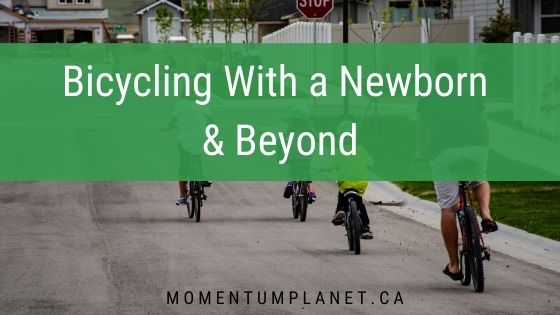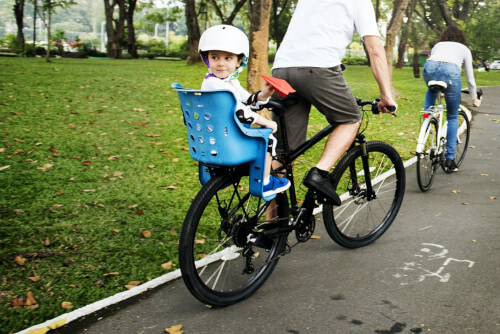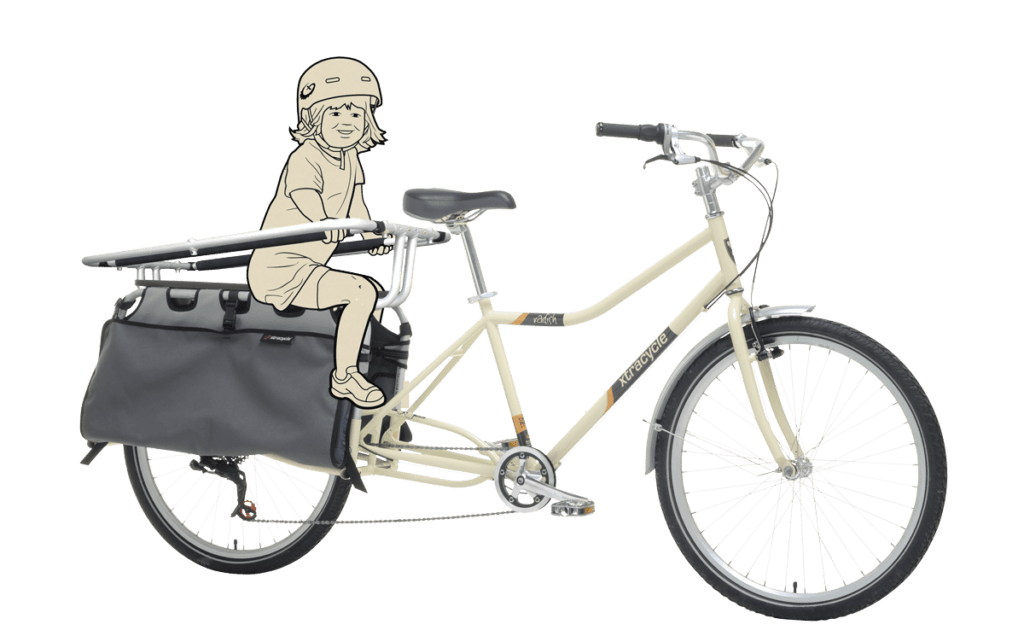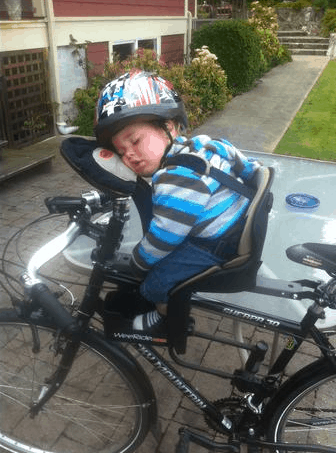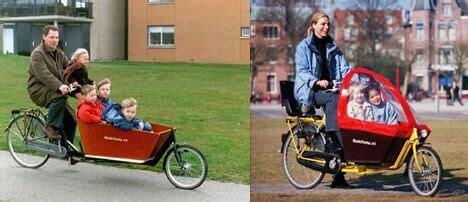When cyclists have babies, wanting to incorporate the kids into the usual transportation routine is pretty natural. Some find it a necessity.
Table of Contents
- At What Age is it Safe to Ride a Bike With Your Newborn?
- Bike Seats or Trailers for Babes & Toddlers
- Cycling While Pregnant & Beyond
- Growing with Children
At What Age is it Safe to Ride a Bike With Your Newborn?
When the child can support his or her own neck, at around the age of one, is the consensus for the age at which a newborn can begin riding in his or her own bike seat. Appropriate bike trailers are reasonably safe for newborns, particularly when your newborn is buckled into a regular car seat that is strapped into a well-constructed trailer (from Thule, Croozer or Burley, for example). Use your own discretion.
In certain circumstances, biking with a child trailer has fewer risks. If you are really set on biking with a baby or young child, the following suggestions from BCHealth can help you minimize the risk of injury:
- Children younger than 1 year should not ride in any type of seat mounted on your bicycle. Before sitting in a rear-mounted seat, your child must sit well without support and be able to wear a lightweight helmet. These types of child carriers must:
- Attach securely over the rear wheel.
- Have spoke guards so your child’s hands and feet will not get caught in the wheels.
- Have a secure shoulder harness, lap belt, and a high back. A child should be able to fall asleep and be well supported.
- If you are using a trailer seat for your child, always have him or her wear a lightweight infant bike helmet.
- Be careful where you ride. Do not ride with your child on busy streets, even where there is a bike lane. Try to ride in bicycle-only areas, such as recreational paths.
- Do not ride with your child during bad weather.
- Never carry infants in backpacks or front packs on a bike.
- Remember to take frequent breaks when carrying your infant in a bike seat or trailer. The standard advice for car seats also applies to the Baby Seat: never leave your child in the seat for more than an hour or two at a time. The back and abdominal muscles of your baby are not strong enough and need to relax now and then. Take a break and let them stretch out and rest for a while.
Bike Seats or Trailers for Babes & Toddlers
CYCLING WITH YOUR BABY: HOW OLD DOES MY INFANT HAVE TO BE TO RIDE IN THE BICYCLE TRAILER?
Look for a trailer like the Croozer that provides a protective cocoon for young passengers in traffic:
- Children from 0 to 6 years of age can ride in the Croozer.
- Unlike a child bike seat, the trailer has a safe and roomy passenger compartment with a full internal roll cage that completely surrounds your child, providing unbeatable protection from all sides.
- The Croozer Baby Seat was specially designed for infants aged 1 to 10 months, with safety as the top priority.
- The Baby Seat is mounted to the trailer frame at eight attachment sites. This system is not only incredibly stable, but also absorbs shocks and vibrations. The infant “floats” in a safe and secure baby hammock inside the passenger compartment of the child trailer.
Compared to child bike seats, trailers tend to be safer.
- Trailer Pro: A good-quality trailer (Thule, Burley) provides protection to your child in the event of a crash or a tip-over.
- With a bike seat, if the parent crashes, the child does, too.
- Bike Seat Pro: with a front-mounted bike seat you have your child close by where you can talk to and easily interact with them.
- In a trailer, it is much harder to see and hear how your child is doing.
- A bike seat is also much lighter than a trailer, which can create a lot of drag when you are climbing hills.
Fred’s son used to wail inconsolably every time they went on a car trip. “You know there’s that baby thing where you drive them around the block and they go to sleep?” Fred says. “He was like, ‘I’m strapped in, and nobody’s holding me, and when I scream they can’t pick me up because they’re driving.’”
So he and his family sold their car and decided to get around by bicycle instead.
“You put him in the bike seat and he’s asleep in five minutes,” Fred says of his son, now two. “He’s just a bicycle baby.” The family owns several bikes, including a Breezer Villager equipped with an XtraCycle, a BoBike seat, and a Wilderness Energy power system.
This family is part of a new generation that’s happily realizing that having “two kids” does not always end in “and a minivan.”
The birth of Chicago resident and avid cyclist Natalie’s first child put a temporary halt to her riding. But after her second child came along, she received a bike trailer as a gift. “That was my epiphany moment,” Natalie says. “I took the kids out for a ride and thought ‘Wow, this is so cool.’”
For her, cycling is not only important for the environment, it’s important for health. “We live in a low-income community with a really high rate of obesity,” Natalie says. “I want my kids to be physically active.”
Today, she leads a popular Friday night bike ride for her own three children (ages from 4 to 10) and up to 15 other neighbourhood kids.
The kids love it, and the neighbourhood parents like it too. “They’re happy we’re doing something positive.”
Cycling While Pregnant & Beyond
In the 1990s, Pat rode her bike to work 45 minutes each way – and she didn’t let a little thing like pregnancy stop her. She cycled till she was practically “kicking myself in the stomach,” she laughs. Many years later, Pat and her family of four are still car-free.
“We had all these different stages,” Pat says. “We had one kid in the trailer, and then one kid in the trailer and one kid on the bike backseat, and then we had two kids in the trailer, then one in the trailer and one on the trail-a-bike.”
Pat says half the battle of being a car-free family is simply deciding to make it work. “There are two kinds of opposing halves: one is planning carefully, and the other is just to assume you can do it. You’re going to be able to get around without a car, which isn’t always bikes. But you’re going to be able to get around.”
Two years ago, when their son came along, Pete and Sue wanted to keep cycling. But the bike trailer was out. “In Sue’s mind it was safer to have our son where she could see him rather than dragged behind,” says Pete, “especially in heavy traffic.”
That’s when Pete stumbled on the bakfiets, or “box bike,” which puts the child and cargo in front of the rider. He imported one from Holland, and when Lucas was old enough, they took him for his first ride. “He loved it from day one. We went down the seawall and he was just pointing at things, going, ‘boat’, ‘bike’, pointing at people.”
Rain City Bikes was the first to distribute the bakfiets in Canada. “We had a couple of moms roll in with a kid on the front, a kid on the back, and panniers… the bikes were unsteady and wobbling on a kickstand,” says Rain City Bikes. “That’s the perfect customer, somebody who’s outgrown the bicycle and needs something more.”
Families who cycle are passionate about the benefits. “Cycling teaches kids how to be independent and how to get around on their own power,” says Natalie. Her children are also “really clued in to the seasons” because of how much time they spend outdoors.
Growing with Children
But cycling with the family isn’t always peachy keen, and it changes as kids go through different stages. Amelie bikes her six-year-old daughter to school on a trail-a-bike almost every day. “She hates it,” Amelie admits. “She would like to just sit on the back [and not pedal], and I’m not strong enough.” Another thing Amelie finds frustrating: the lack of bike racks at her daughter’s school. “It rains for nine months of the year here; it’s crazy not to have covered bike racks.”
According to Natalie, the hardest part about family cycling is going on longer trips with four bikes and a trailer. Being able to take your bike on public transit has made things easier, but it’s “not really designed for family use. There’d be room for just two bikes and then there’d be the trailer.”
But for these families, the good points far outweigh the challenges.
“When you’re cycling, you’re out in the world, you’re engaged with the world in a way you can’t be with a car,” Amelie says.
